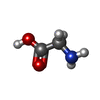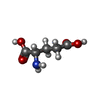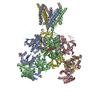+ Open data
Open data
- Basic information
Basic information
| Entry |  | |||||||||
|---|---|---|---|---|---|---|---|---|---|---|
| Title | Open state of Gly-,Glu-,EU1622-240 bound GluN1a-2B-2D NMDAR | |||||||||
 Map data Map data | Composite map | |||||||||
 Sample Sample |
| |||||||||
 Keywords Keywords | N-methyl-D-aspartate receptor / open / GluN2B / GluN2D / MEMBRANE PROTEIN | |||||||||
| Function / homology |  Function and homology information Function and homology informationregulation of sensory perception of pain / glycine-gated cation channel activity / excitatory chemical synaptic transmission / Activated NTRK2 signals through FYN / Synaptic adhesion-like molecules / response to glycine / propylene metabolic process / cellular response to L-glutamate / negative regulation of dendritic spine maintenance / Assembly and cell surface presentation of NMDA receptors ...regulation of sensory perception of pain / glycine-gated cation channel activity / excitatory chemical synaptic transmission / Activated NTRK2 signals through FYN / Synaptic adhesion-like molecules / response to glycine / propylene metabolic process / cellular response to L-glutamate / negative regulation of dendritic spine maintenance / Assembly and cell surface presentation of NMDA receptors / regulation of monoatomic cation transmembrane transport / NMDA glutamate receptor activity / voltage-gated monoatomic cation channel activity / NMDA selective glutamate receptor complex / Neurexins and neuroligins / glutamate binding / ligand-gated sodium channel activity / neurotransmitter receptor complex / glutamate receptor signaling pathway / calcium ion transmembrane import into cytosol / protein heterotetramerization / glycine binding / startle response / monoatomic cation transmembrane transport / positive regulation of reactive oxygen species biosynthetic process / Negative regulation of NMDA receptor-mediated neuronal transmission / Unblocking of NMDA receptors, glutamate binding and activation / positive regulation of calcium ion transport into cytosol / Long-term potentiation / excitatory synapse / monoatomic cation transport / regulation of neuronal synaptic plasticity / monoatomic ion channel complex / positive regulation of excitatory postsynaptic potential / synaptic cleft / positive regulation of synaptic transmission, glutamatergic / calcium ion homeostasis / glutamate-gated receptor activity / MECP2 regulates neuronal receptors and channels / glutamate-gated calcium ion channel activity / presynaptic active zone membrane / EPHB-mediated forward signaling / ligand-gated monoatomic ion channel activity involved in regulation of presynaptic membrane potential / ionotropic glutamate receptor signaling pathway / sodium ion transmembrane transport / Ras activation upon Ca2+ influx through NMDA receptor / synaptic membrane / hippocampal mossy fiber to CA3 synapse / adult locomotory behavior / regulation of membrane potential / excitatory postsynaptic potential / transmitter-gated monoatomic ion channel activity involved in regulation of postsynaptic membrane potential / synaptic transmission, glutamatergic / postsynaptic density membrane / brain development / regulation of synaptic plasticity / visual learning / calcium ion transmembrane transport / long-term synaptic potentiation / terminal bouton / synaptic vesicle / late endosome / signaling receptor activity / amyloid-beta binding / RAF/MAP kinase cascade / response to ethanol / dendritic spine / chemical synaptic transmission / postsynaptic membrane / learning or memory / cytoskeleton / calmodulin binding / lysosome / neuron projection / postsynaptic density / calcium ion binding / synapse / dendrite / endoplasmic reticulum membrane / protein-containing complex binding / glutamatergic synapse / cell surface / positive regulation of transcription by RNA polymerase II / zinc ion binding / plasma membrane / cytoplasm Similarity search - Function | |||||||||
| Biological species |  Homo sapiens (human) Homo sapiens (human) | |||||||||
| Method | single particle reconstruction / cryo EM / Resolution: 3.95 Å | |||||||||
 Authors Authors | Hyunook K / Hiro F | |||||||||
| Funding support |  United States, 2 items United States, 2 items
| |||||||||
 Citation Citation |  Journal: Neuron / Year: 2025 Journal: Neuron / Year: 2025Title: Structural basis for channel gating and blockade in tri-heteromeric GluN1-2B-2D NMDA receptor. Authors: Hyunook Kang / Max Epstein / Tue G Banke / Riley Perszyk / Noriko Simorowski / Srinu Paladugu / Dennis C Liotta / Stephen F Traynelis / Hiro Furukawa /  Abstract: Discrete activation of N-methyl-D-aspartate receptor (NMDAR) subtypes by glutamate and the co-agonist glycine is fundamental to neuroplasticity. A distinct variant, the tri-heteromeric receptor, ...Discrete activation of N-methyl-D-aspartate receptor (NMDAR) subtypes by glutamate and the co-agonist glycine is fundamental to neuroplasticity. A distinct variant, the tri-heteromeric receptor, comprising glycine-binding GluN1 and two types of glutamate-binding GluN2 subunits, exhibits unique pharmacological characteristics, notably enhanced sensitivity to the anti-depressant channel blocker S-(+)-ketamine. Despite its significance, the structural mechanisms underlying ligand gating and channel blockade of tri-heteromeric NMDARs remain poorly understood. Here, we identify and characterize tri-heteromeric GluN1-2B-2D NMDAR in the adult brain, resolving its structures in the activated, inhibited, and S-(+)-ketamine-blocked states. These structures reveal the ligand-dependent conformational dynamics that modulate the tension between the extracellular domain and transmembrane channels, governing channel gating and blockade. Additionally, we demonstrate that the inhibitor (S)-DQP-997-74 selectively decouples linker tension in GluN2D, offering insights into subtype-selective targeting for cognitive modulation. | |||||||||
| History |
|
- Structure visualization
Structure visualization
| Supplemental images |
|---|
- Downloads & links
Downloads & links
-EMDB archive
| Map data |  emd_46527.map.gz emd_46527.map.gz | 229.4 MB |  EMDB map data format EMDB map data format | |
|---|---|---|---|---|
| Header (meta data) |  emd-46527-v30.xml emd-46527-v30.xml emd-46527.xml emd-46527.xml | 28.9 KB 28.9 KB | Display Display |  EMDB header EMDB header |
| FSC (resolution estimation) |  emd_46527_fsc.xml emd_46527_fsc.xml | 13.3 KB | Display |  FSC data file FSC data file |
| Images |  emd_46527.png emd_46527.png | 57.2 KB | ||
| Filedesc metadata |  emd-46527.cif.gz emd-46527.cif.gz | 8.4 KB | ||
| Others |  emd_46527_additional_1.map.gz emd_46527_additional_1.map.gz emd_46527_additional_2.map.gz emd_46527_additional_2.map.gz emd_46527_additional_3.map.gz emd_46527_additional_3.map.gz | 229.9 MB 230.3 MB 230.3 MB | ||
| Archive directory |  http://ftp.pdbj.org/pub/emdb/structures/EMD-46527 http://ftp.pdbj.org/pub/emdb/structures/EMD-46527 ftp://ftp.pdbj.org/pub/emdb/structures/EMD-46527 ftp://ftp.pdbj.org/pub/emdb/structures/EMD-46527 | HTTPS FTP |
-Validation report
| Summary document |  emd_46527_validation.pdf.gz emd_46527_validation.pdf.gz | 189.4 KB | Display |  EMDB validaton report EMDB validaton report |
|---|---|---|---|---|
| Full document |  emd_46527_full_validation.pdf.gz emd_46527_full_validation.pdf.gz | 189 KB | Display | |
| Data in XML |  emd_46527_validation.xml.gz emd_46527_validation.xml.gz | 504 B | Display | |
| Data in CIF |  emd_46527_validation.cif.gz emd_46527_validation.cif.gz | 452 B | Display | |
| Arichive directory |  https://ftp.pdbj.org/pub/emdb/validation_reports/EMD-46527 https://ftp.pdbj.org/pub/emdb/validation_reports/EMD-46527 ftp://ftp.pdbj.org/pub/emdb/validation_reports/EMD-46527 ftp://ftp.pdbj.org/pub/emdb/validation_reports/EMD-46527 | HTTPS FTP |
-Related structure data
| Related structure data |  9d38MC  9d37C  9d39C  9d3aC  9d3bC  9d3cC M: atomic model generated by this map C: citing same article ( |
|---|---|
| Similar structure data | Similarity search - Function & homology  F&H Search F&H Search |
- Links
Links
| EMDB pages |  EMDB (EBI/PDBe) / EMDB (EBI/PDBe) /  EMDataResource EMDataResource |
|---|---|
| Related items in Molecule of the Month |
- Map
Map
| File |  Download / File: emd_46527.map.gz / Format: CCP4 / Size: 244.1 MB / Type: IMAGE STORED AS FLOATING POINT NUMBER (4 BYTES) Download / File: emd_46527.map.gz / Format: CCP4 / Size: 244.1 MB / Type: IMAGE STORED AS FLOATING POINT NUMBER (4 BYTES) | ||||||||||||||||||||||||||||||||||||
|---|---|---|---|---|---|---|---|---|---|---|---|---|---|---|---|---|---|---|---|---|---|---|---|---|---|---|---|---|---|---|---|---|---|---|---|---|---|
| Annotation | Composite map | ||||||||||||||||||||||||||||||||||||
| Projections & slices | Image control
Images are generated by Spider. | ||||||||||||||||||||||||||||||||||||
| Voxel size | X=Y=Z: 0.861 Å | ||||||||||||||||||||||||||||||||||||
| Density |
| ||||||||||||||||||||||||||||||||||||
| Symmetry | Space group: 1 | ||||||||||||||||||||||||||||||||||||
| Details | EMDB XML:
|
-Supplemental data
-Additional map: TMD local refined map
| File | emd_46527_additional_1.map | ||||||||||||
|---|---|---|---|---|---|---|---|---|---|---|---|---|---|
| Annotation | TMD local refined map | ||||||||||||
| Projections & Slices |
| ||||||||||||
| Density Histograms |
-Additional map: ECD local refined map
| File | emd_46527_additional_2.map | ||||||||||||
|---|---|---|---|---|---|---|---|---|---|---|---|---|---|
| Annotation | ECD local refined map | ||||||||||||
| Projections & Slices |
| ||||||||||||
| Density Histograms |
-Additional map: Consensus map
| File | emd_46527_additional_3.map | ||||||||||||
|---|---|---|---|---|---|---|---|---|---|---|---|---|---|
| Annotation | Consensus map | ||||||||||||
| Projections & Slices |
| ||||||||||||
| Density Histograms |
- Sample components
Sample components
-Entire : tri-heteromeric GluN1-2B-2D NMDAR
| Entire | Name: tri-heteromeric GluN1-2B-2D NMDAR |
|---|---|
| Components |
|
-Supramolecule #1: tri-heteromeric GluN1-2B-2D NMDAR
| Supramolecule | Name: tri-heteromeric GluN1-2B-2D NMDAR / type: complex / ID: 1 / Parent: 0 / Macromolecule list: #1-#3 |
|---|---|
| Source (natural) | Organism:  Homo sapiens (human) Homo sapiens (human) |
| Molecular weight | Theoretical: 377 KDa |
-Macromolecule #1: Glutamate receptor ionotropic, NMDA 1
| Macromolecule | Name: Glutamate receptor ionotropic, NMDA 1 / type: protein_or_peptide / ID: 1 / Number of copies: 2 / Enantiomer: LEVO |
|---|---|
| Source (natural) | Organism:  Homo sapiens (human) Homo sapiens (human) |
| Molecular weight | Theoretical: 92.691828 KDa |
| Recombinant expression | Organism:  |
| Sequence | String: DPKIVNIGAV LSTRKHEQMF REAVNQANKR HGSWKIQLNA TSVTHKPNAI QMALSVCEDL ISSQVYAILV SHPPTPNDHF TPTPVSYTA GFYRIPVLGL TTRMSIYSDK SIHLSFLRTV PPYSHQSSVW FEMMRVYSWN HIILLVSDDH EGRAAQKRLE T LLEERESK ...String: DPKIVNIGAV LSTRKHEQMF REAVNQANKR HGSWKIQLNA TSVTHKPNAI QMALSVCEDL ISSQVYAILV SHPPTPNDHF TPTPVSYTA GFYRIPVLGL TTRMSIYSDK SIHLSFLRTV PPYSHQSSVW FEMMRVYSWN HIILLVSDDH EGRAAQKRLE T LLEERESK AEKVLQFDPG TKNVTALLME AKELEARVII LSASEDDAAT VYRAAAMLNM TGSGYVWLVG EREISGNALR YA PDGILGL QLINGKNESA HISDAVGVVA QAVHELLEKE NITDPPRGCV GNTNIWKTGP LFKRVLMSSK YADGVTGRVE FNE DGDRKF ANYSIMNLQN RKLVQVGIYN GTHVIPNDRK IIWPGGETEK PRGYQMSTRL KIVTIHQEPF VYVKPTLSDG TCKE EFTVN GDPVKKVICT GPNDTSPGSP RHTVPQCCYG FCIDLLIKLA RTMNFTYEVH LVADGKFGTQ ERVNNSNKKE WNGMM GELL SGQADMIVAP LTINNERAQY IEFSKPFKYQ GLTILVKKEI PRSTLDSFMQ PFQSTLWLLV GLSVHVVAVM LYLLDR FSP FGRFKVNSEE EEEDALTLSS AMWFSWGVLL NSGIGEGAPR SFSARILGMV WAGFAMIIVA SYTANLAAFL VLDRPEE RI TGINDPRLRN PSDKFIYATV KQSSVDIYFR RQVELSTMYR HMEKHNYESA AEAIQAVRDN KLHAFIWDSA VLEFEASQ K CDLVTTGELF FRSGFGIGMR KDSPWKQNVS LSILKSHENG FMEDLDKTWV RYQECDSRSN APATLTFENM AGVFMLVAG GIVAGIFLIF IEIAYKRHKD ANGAQ UniProtKB: Glutamate receptor ionotropic, NMDA 1 |
-Macromolecule #2: Glutamate receptor ionotropic, NMDA 2B
| Macromolecule | Name: Glutamate receptor ionotropic, NMDA 2B / type: protein_or_peptide / ID: 2 Details: twin-Strep-tag (WSHPQFEKGGGSGGGSGGSAWSHPQFEKGALVPRG) C-terminal p2A tag (GSGATNFSLLKQAGDVEENPG) Number of copies: 1 / Enantiomer: LEVO |
|---|---|
| Source (natural) | Organism:  Homo sapiens (human) Homo sapiens (human) |
| Molecular weight | Theoretical: 98.622172 KDa |
| Recombinant expression | Organism:  |
| Sequence | String: WSHPQFEKGG GSGGGSGGSA WSHPQFEKGA LVPRGRSQKS PPSIGIAVIL VGTSDEVAIK DAHEKDDFHH LSVVPRVELV AMNETDPKS IITRICDLMS DRKIQGVVFA DDTDQEAIAQ ILDFISAQTL TPILGIHGGS SMIMADKDES SMFFQFGPSI E QQASVMLN ...String: WSHPQFEKGG GSGGGSGGSA WSHPQFEKGA LVPRGRSQKS PPSIGIAVIL VGTSDEVAIK DAHEKDDFHH LSVVPRVELV AMNETDPKS IITRICDLMS DRKIQGVVFA DDTDQEAIAQ ILDFISAQTL TPILGIHGGS SMIMADKDES SMFFQFGPSI E QQASVMLN IMEEYDWYIF SIVTTYFPGY QDFVNKIRST IENSFVGWEL EEVLLLDMSL DDGDSKIQNQ LKKLQSPIIL LY CTKEEAT YIFEVANSVG LTGYGYTWIV PSLVAGDTDT VPAEFPTGLI SVSYDEWDYG LPARVRDGIA IITTAASDML SEH SFIPEP KSSCYNTHEK RIYQSNMLNR YLINVTFEGR NLSFSEDGYQ MHPKLVIILL NKERKWERVG KWKDKSLQMK YYVW PRMCP ETEEQEDDHL SIVTLEEAPF VIVESVDPLS GTCMRNTVPC QKRIVTENKT DEEPGYIKKC CKGFCIDILK KISKS VKFT YDLYLVTNGK HGKKINGTWN GMIGEVVMKR AYMAVGSLTI NEERSEVVDF SVPFIETGIS VMVSRSNGTV SPSAFL EPF SADVWVMMFV MLLIVSAVAV FVFEYFSPVG YNRSLADGRE PGGPSFTIGK AIWLLWGLVF NNSVPVQNPK GTTSKIM VS VWAFFAVIFL ASYTANLAAF MIQEEYVDQV SGLSDKKFQR PNDFSPPFRF GTVPNGSTER NIRNNYAEMH AYMGKFNQ R GVDDALLSLK TGKLDAFIYD AAVLNYMAGR DEGCKLVTIG SGKVFASTGY GIAIQKDSGW KRQVDLAILQ LFGDGEMEE LEALWLTGIC HNEKNEVMSS QLDIDNMAGV FYMLGAAMAL SLITFISEHL FYWQFRHSFM GGPGSGATNF SLLKQAGDVE ENPG UniProtKB: Glutamate receptor ionotropic, NMDA 2B |
-Macromolecule #3: Glutamate receptor ionotropic, NMDA 2D
| Macromolecule | Name: Glutamate receptor ionotropic, NMDA 2D / type: protein_or_peptide / ID: 3 / Details: 1D4 tag: TETSQVAPA / Number of copies: 1 / Enantiomer: LEVO |
|---|---|
| Source (natural) | Organism:  Homo sapiens (human) Homo sapiens (human) |
| Molecular weight | Theoretical: 94.120609 KDa |
| Recombinant expression | Organism:  |
| Sequence | String: FPEEAPGPGG AGGPGGGLGG ARPLNVALVF SGPAYAAEAA RLGPAVAAAV RSPGLDVRPV ALVLNGSDPR SLVLQLCDLL SGLRVHGVV FEDDSRAPAV APILDFLSAQ TSLPIVAVHG GAALVLTPKE KGSTFLQLGS STEQQLQVIF EVLEEYDWTS F VAVTTRAP ...String: FPEEAPGPGG AGGPGGGLGG ARPLNVALVF SGPAYAAEAA RLGPAVAAAV RSPGLDVRPV ALVLNGSDPR SLVLQLCDLL SGLRVHGVV FEDDSRAPAV APILDFLSAQ TSLPIVAVHG GAALVLTPKE KGSTFLQLGS STEQQLQVIF EVLEEYDWTS F VAVTTRAP GHRAFLSYIE VLTDGSLVGW EHRGALTLDP GAGEAVLSAQ LRSVSAQIRL LFCAREEAEP VFRAAEEAGL TG SGYVWFM VGPQLAGGGG SGAPGEPPLL PGGAPLPAGL FAVRSAGWRD DLARRVAAGV AVVARGAQAL LRDYGFLPEL GHD CRAQNR THRGESLHRY FMNITWDNRD YSFNEDGFLV NPSLVVISLT RDRTWEVVGS WEQQTLRLKY PLWSRYGRFL QPVD DTQHL TVATLEERPF VIVEPADPIS GTCIRDSVPC RSQLNRTHSP PPDAPRPEKR CCKGFCIDIL KRLAHTIGFS YDLYL VTNG KHGKKIDGVW NGMIGEVFYQ RADMAIGSLT INEERSEIVD FSVPFVETGI SVMVARSNGT VSPSAFLEPY SPAVWV MMF VMCLTVVAVT VFIFEYLSPV GYNRSLATGK RPGGSTFTIG KSIWLLWALV FNNSVPVENP RGTTSKIMVL VWAFFAV IF LASYTANLAA FMIQEEYVDT VSGLSDRKFQ RPQEQYPPLK FGTVPNGSTE KNIRSNYPDM HSYMVRYNQP RVEEALTQ L KAGKLDAFIY DAAVLNYMAR KDEGCKLVTI GSGKVFATTG YGIALHKGSR WKRPIDLALL QFLGDDEIEM LERLWLSGI CHNDKIEVMS SKLDIDNMAG VFYMLLVAMG LSLLVFAWEH LVYWRLRHCL GPTETSQVAP A UniProtKB: Glutamate receptor ionotropic, NMDA 2D |
-Macromolecule #5: GLYCINE
| Macromolecule | Name: GLYCINE / type: ligand / ID: 5 / Number of copies: 2 / Formula: GLY |
|---|---|
| Molecular weight | Theoretical: 75.067 Da |
| Chemical component information |  ChemComp-GLY: |
-Macromolecule #6: 2-acetamido-2-deoxy-beta-D-glucopyranose
| Macromolecule | Name: 2-acetamido-2-deoxy-beta-D-glucopyranose / type: ligand / ID: 6 / Number of copies: 3 / Formula: NAG |
|---|---|
| Molecular weight | Theoretical: 221.208 Da |
| Chemical component information |  ChemComp-NAG: |
-Macromolecule #7: GLUTAMIC ACID
| Macromolecule | Name: GLUTAMIC ACID / type: ligand / ID: 7 / Number of copies: 2 / Formula: GLU |
|---|---|
| Molecular weight | Theoretical: 147.129 Da |
| Chemical component information |  ChemComp-GLU: |
-Experimental details
-Structure determination
| Method | cryo EM |
|---|---|
 Processing Processing | single particle reconstruction |
| Aggregation state | particle |
- Sample preparation
Sample preparation
| Concentration | 2 mg/mL |
|---|---|
| Buffer | pH: 7.5 |
| Grid | Model: Quantifoil R1.2/1.3 / Material: COPPER / Mesh: 300 |
| Vitrification | Cryogen name: ETHANE / Chamber humidity: 100 % / Chamber temperature: 278 K / Instrument: FEI VITROBOT MARK IV |
- Electron microscopy
Electron microscopy
| Microscope | FEI TITAN KRIOS |
|---|---|
| Specialist optics | Energy filter - Name: GIF Bioquantum / Energy filter - Slit width: 14 eV |
| Image recording | Film or detector model: GATAN K3 BIOQUANTUM (6k x 4k) / Average electron dose: 63.3 e/Å2 |
| Electron beam | Acceleration voltage: 300 kV / Electron source:  FIELD EMISSION GUN FIELD EMISSION GUN |
| Electron optics | Illumination mode: FLOOD BEAM / Imaging mode: BRIGHT FIELD / Nominal defocus max: 2.4 µm / Nominal defocus min: 1.0 µm |
| Sample stage | Cooling holder cryogen: NITROGEN |
| Experimental equipment |  Model: Titan Krios / Image courtesy: FEI Company |
+ Image processing
Image processing
-Atomic model buiding 1
| Initial model |
| ||||||||||
|---|---|---|---|---|---|---|---|---|---|---|---|
| Refinement | Space: REAL / Protocol: RIGID BODY FIT | ||||||||||
| Output model |  PDB-9d38: |
 Movie
Movie Controller
Controller

























 Z (Sec.)
Z (Sec.) Y (Row.)
Y (Row.) X (Col.)
X (Col.)















































